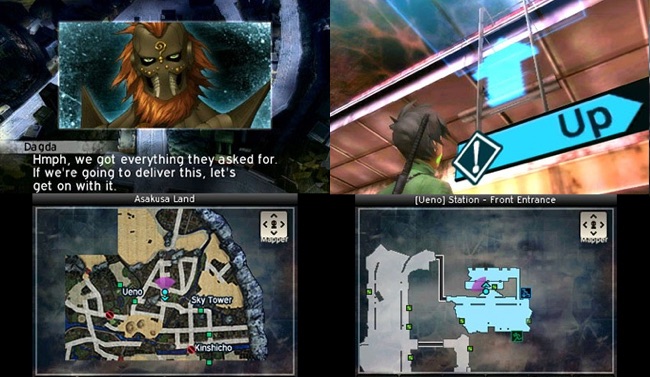
To the fans of the core Shin Megami Tensei (SMT) series of JRPGs by developer Atlus, I believe I am the worst kind of person – a Persona fan. My first foray into this series was with the popular spin-off, Persona 4. After adoring every second of this, I proceeded to play every form of modern Persona I could. My only attempt at any of the main series was my partial playthrough of SMTIV, which I enjoyed but never finished. Hearing good things about the follow-up of that game, SMTIV: Apocalypse for the 3DS, I decided to venture in once more and see if I could finally earn my place in the ranks of SMT players.
Before we kick into things, let’s get the context sorted out. The story starts out in the later stages of the prior tale’s “Neutral ending,” right before the final boss sequence. Our new lead character, Nanashi, is introduced as a replacement ‘hero’ of this storyline, and from there the plot is essentially independent. While you see the expected returning characters and references, it is perfectly feasible to play through this without having touched the first game.
In fact, if you’ve not played an SMT title before, this may be for the best. Many levels are re-used, along with certain bosses, which may be uninteresting to anyone returning, but are well designed enough to interest the new players. The introductory levels of Apocalypse are vastly improved, offering a steady introduction of reasonable difficulty, in vast contrast to the previous one which providing a punishing start.

It’s clear that a large amount of the game is much easier than the first. As I slaughtered my way through the many enemies and bosses, it was not until the very last boss that I really had to slow down and consider my options. Perhaps I had simply trained my demons well and gained plenty of experience from completing every side-quest; however, a game’s difficulty should not be lost from finishing all of its content. On top of this, the challenge of the final boss feels strangely out of place after a mostly painless journey to it.
Luckily, as easy as it is, the actual combat system is interesting and offers many complex decisions. From digging around online, it seems to have been used in some previous SMT games and is known as the Press Turn system, whereby hitting an enemy’s weaknesses yields extra turns on top of bonus damage. There are plenty of intricacies to this, and playing it to your advantage is incredibly satisfying. Enemies operate the same way, though, so there can be a feeling of equal despair by an enemy playing your team for all its weaknesses.
Your party will consist of your main character and a collection of demons. Training and managing your demons is central to being effective in battle. They will learn new abilities frequently, but only for a few levels before they run out of new things to learn. This combination keeps the concept of levelling up rewarding and encourages you to continually update your demon collection, instead of allowing you to grow stagnant with a set team.

You may be asking, “Why bother learning new abilities if you’re just going to be replacing them with new demons?” Well, this is easily addressed by the unholy concept of demon fusion. Almost any two demons can be combined into a brand-new third demon, who takes abilities of your choice from the first two, along with a couple new ones. I had a blast considering my fusion options and what abilities to pass on. Party planning has never been more entertaining.
There is another method of obtaining new demons: those you encounter in any non-story fight can be recruited. However, the system is very hard to predict and features a lot of randomisation. They are recruited through a conversation in which you try to appease them. If successful, you then offer them items of their desire until they decide to join you. In practice, it is never this simple. There is a knack to it that will come with practice, but this never really feels like it was solely your skill that won over your target when chatting with demons is so wild. There’s always the risk of an entirely random outcome; very little hurts more than giving a demon plenty of money and precious items, only to have it run off for no real reason.
Thankfully, several systems have been implemented to reduce this frustration. Clearly, all the terrible luck can be met with respective good luck, in which demons will occasionally join you immediately on request. Similarly, recruiting any that you’ve obtained previously will occasionally result in an instant success, as the demon recognises you and happily joins back into your fold. You’re also able to put resources towards just purchasing a demon back from a list of every demon you’ve owned. The ability to fall back onto such a simple solution was greatly appreciated when hunting for a particular demon became exhausting.

The overall plot of the game is simply weaker than the original, but that may be unavoidable for any tale that picks up from the back-end of another. The new lead is not inherently special in any particular way, and the introduced villain doesn’t bring anything unique with him. Every major event in the story was extremely predictable, which particularly put me off, as I value a story that can incorporate something new or unexpected.
The overall philosophical discussion of the game is also a step down from the original. SMTIV was about the difference between chaos and order, containing some fascinating insight into both sides of that argument and some well-written discussions. Apocalypse is about the difference between unity and independence, but in a flat and direct way. The ‘Pro-Unity’ side of things really boils down to your travelling team acknowledging how well they handle things together, while the ‘Pro-Independence’ backer continually insists that the team is ‘holding you back,’ although no evidence of this fact is evident in the game.
The characters that join your troupe don’t offer much interest either. They each have their own ‘traits’ which colour their dialogue and rarely change. Those that do change do so in single giant leaps with minimal to no real development leading up to this change. For a game that was partially about the strength of togetherness, it was important that the team feels alive, and the writers entirely missed on this front.

The characters may not be interesting, but they are at least well designed in a more practical sense. The art design behind all the characters, playable and otherwise, helps create a strong sense of the world of Apocalypse, scavenging for whatever you can find in a disaster-stricken Tokyo. The voice-acting is very strong and almost always present, greatly helping alleviate the overall weakness of their personality and development.
In case you’re entirely new to the SMT universe, the demon design is extremely diverse and unusual. They tend to re-use a large amount of demons between games in the series, so I did recognise many from my time with Persona. Discovering these demons for the first time is a delight, as they range from fairly simple and odd creatures, to absolutely absurd abominations.
As a final note, I would like to observe just how snappy each and every element of the game is. Loading times are minimal, almost all dialogue can be fast-forwarded through, cut-scenes like demon-fusion can be entirely skipped, and auto-battle is rapid and easy to turn on-and-off. As anything ‘slow’ in a game like this can be agonising, it’s a delight to see how well all the different methods of speeding things up have been implemented.

While the characters and plot may not be the strongest I’ve ever seen in a JRPG before, all of the active gameplay is interesting and well thought out. Between collecting demons and the mix of simplicity and flexibility in training your demons, it feels like a more mature form of Pokémon. Whether you’re a long-term Shin Megami Tensei fan, someone brand new to the series, or someone in-between like me, there’s something for you to love in the world of Shin Megami Tensei IV: Apocalypse.











